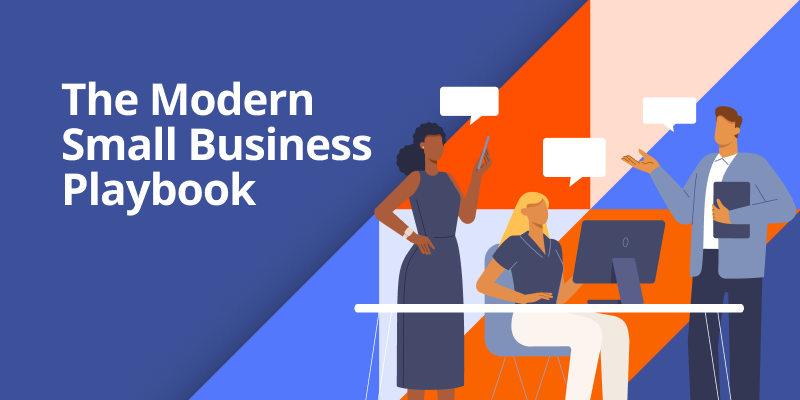Congratulations. You’ve just invented your latest and greatest product. Now, it’s time to sit back and watch it sell itself, right?
If you’re here, you know how tricky it can be to market a product or service. You need to get the word out about your business, and you need to do it right.
Luckily, my team includes some very smart and talented product marketers. I sat down with them to come up with ten of the most effective ways to market your company’s product or service.

Small business marketing software made easy.
Learn MoreHow to Market a Product for Small Business
Let’s start with email marketing. It’s one of the most efficient channels for generating buzz for your business, and there are plenty of ways to use it to promote your product or service.
1. Take advantage of email marketing.
Email is one of the most effective digital marketing platforms. Over 4 billion people use email, and most users check their inboxes daily.
If you have an email automation platform, you can send messages that announce new products and provide links to your website where people can learn more information. Thryv’s Senior Email Marketing Manager, Brittanie Begemen, recommends leveraging AI to create emails that entice customers to visit your landing pages.

2. Get customer reviews.
Over 90% of people make buying decisions based on customer reviews. And nearly as many use Google to evaluate local businesses. Online reviews help you sell products and services – and you should prioritize Google as your top review site.
However, that doesn’t mean sites like Yelp, TripAdvisor, and Angi aren’t important. Consider using a reputation management tool to monitor these channels from one dashboard. That way, you don’t have to jump between apps, and you’ll get alerts when new reviews are left on each site.
Here’s an example of what a reputation management tool looks like:
Good customer reviews help you rank higher on Google. When potential customers search for businesses in your area, Google will factor your reviews into local search results. Businesses with better reviews appear more often than those with poor ratings.
3. Leverage paid and organic social media.
Social media is an excellent channel for promoting products and services. You can use organic strategies or pay to advertise on each platform. Both options have their advantages and are used by small business owners.
Organic social media involves creating content and promoting it on your social channels. Rather than paying to advertise, you’re sharing content with your followers and, if done right, people will discover it organically.
While it’s tough to go viral, organic social media is an effective way to market to your existing followers. You can partner with influencers, post videos of happy customers using your product or service, or create relatable content based on trends – like our company does on Instagram:

Paid social media means you pay to advertise to a larger and sometimes targeted audience. You’re not just promoting content to your followers; you’re sharing it with people who might be interested in your business.
Paid social media creates a conversion point for your company. While organic social builds relationships with followers, paid social sells your product or service. The best way to succeed in paid social media campaigns (like the one below) is to choose the right channels and craft effective content.
@Amazon Last chance to Shop Prime Day deals 📦 get ’em before they swipe past you
4. Use paid search ads.
Search ads appear on search engines like Google, Bing, and Yahoo. They target keywords, which are words and phrases that people search for on search engines.
Search ads place your business at the top of search engine results pages, or SERPs. They come in several formats, but they look something like this:

If you don’t have Google Ads, you’ll need it to advertise on Google. From there, its software will help you create ad groups, research keywords, and set a budget for your campaign. It can also analyze the performance of your ads and make recommendations for improving them.

5. Tap into customer data.
Customer data can teach you a lot about marketing your product or service. For example, your CRM is a treasure trove of information because it records customer interactions. You can use it to organize contacts into lists and segment your marketing so you can send different messages to different groups. That way, you can personalize your marketing campaigns and increase customer engagement.
Thryv’s Senior Product Marketing Specialist, Adna Brkanic, uses customer data to craft effective marketing content. She recommends focusing on their needs and pain points and highlighting how your business solves them.

6. Start a blog.
In addition to paying to advertise on search engines, you can create a blog and rank organically in search results with search engine optimization (SEO).
You can start two types of blogs for your business: product blogs and educational blogs. Educational blogs will either teach people something or try to entertain them. This blog you’re reading right now is a great example. It helps you learn how to market your product, and it helps us rank higher on Google. (That’s a win-win, if you ask me.)
Product blogs update customers with the latest news about your business. You can use it to announce the launch of a new product, or let customers know you’ve added a new feature. If you’re a service-based company, you can use your blog to promote deals and limited-time offers so customers keep returning to your site for more.
Pro Tip: Don’t expect success overnight. Blogs are a marathon, not a sprint. You have to consistently publish content over time before ranking higher on search engines.

Modern Small
Business Playbook
Find expert tips and tools to help you streamline communications, automate your marketing efforts, improve your business operations, and more in this free guide.
7. Create a customer loyalty program.
Customer loyalty programs work because they incentivize buyers to keep doing business with you. 90% of business owners with a loyalty program reported positive ROI. Their customers become more loyal because they have a reason to make repeat purchases.
Here’s where you can introduce your latest product or service. Offer early access to it as a perk of your loyalty program. This strategy will drive sales and gather feedback from your most devoted customers.
People outside your program may also be interested in trying your new product. Collect their contact information, such as their email and phone number, and use it to fuel other marketing strategies on this list.
8. Attend trade shows.
Trade shows are an excellent way to get your new products into customers’ hands. If you have samples or prototypes, trade shows are a great place to distribute them. You can speak directly with potential buyers and educate them about your business.
To find trade shows near you, start with a simple Google search for “trade shows near me.” Or, follow sites like Eventbrite and your local Chamber of Commerce for a list of events in your area.
9. Text discount codes via SMS.
According to Gartner, 98% of people open text messages they receive, and most open a text within a few minutes of receiving it. SMS is one the most effective channels for customer engagement because you know there’s a high chance someone will read your message.
SMS is an effective marketing channel for advertising new products and services. You can send customers discounts that they can redeem in-store or online. Since most of us have smartphones, you can provide links to your website so customers can easily reach your store.
Here’s a couple of texts from Home Depot that someone on my team received and shared with me:

This ad gets right to the point and links to the company website. It’s a convenient offer that keeps Home Depot top-of-mind, even if someone’s on the go.
10. Send direct mail.
Direct mail isn’t dead. It’s one of the most preferred marketing channels for Baby Boomers, and over 70% of Gen Z consumers are “excited to see what the mail brings every day.”
Mailers are a great way to let people know you have a new product or service. You can even include a discount that they can redeem in-store or send them a newsletter with updates from your business, similar to how this company does it:

Another option is offering a sample of your product. It lets customers try before buying, which is one of the most effective ways to convince people to consider your business.
Pro Tip: Here are some tips for getting the most out of your direct mail marketing campaign.
Marketing a Product or Service for Small Business
Every business owner should learn to embrace product marketing. You get to highlight the great things your business offers and encourage people to try them.
If you’re unsure where to start, try one of the marketing strategies above. It’ll start to spread the word about your business and generate buzz around your products. From there, a great product can sell itself – once it’s in front of the right buyer at the right time.

Modern Small
Business Playbook
Find expert tips and tools to help you streamline communications, automate your marketing efforts, improve your business operations, and more in this free guide.





